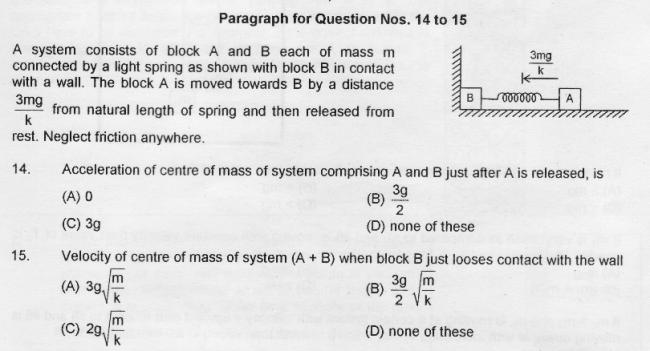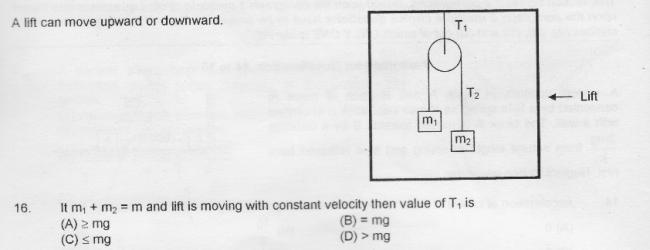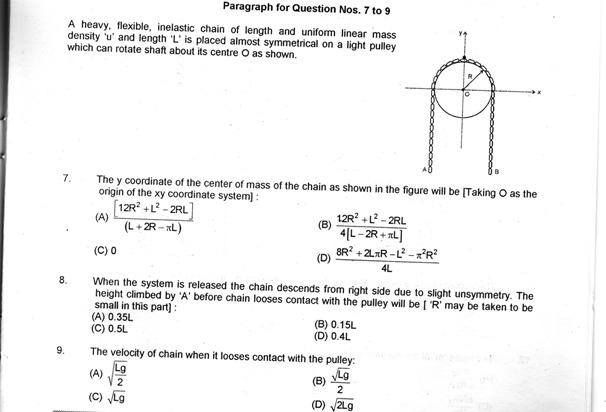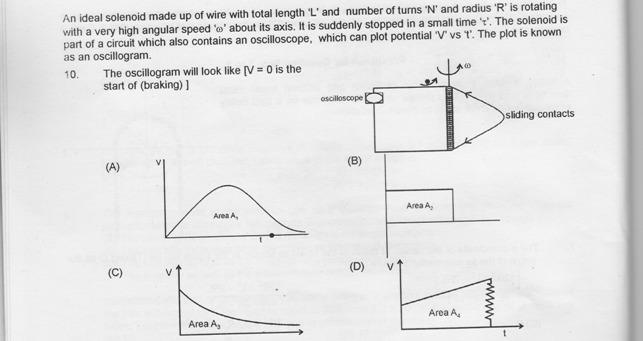thnx swaraj !
i didnt notice the 45o thing before .
24 Answers
Aditya what they have given is correct.There are 2 solns.
1st one is Rnet 2nd is r2 /Rnet
Proof:(after much thinking)
let in case given r of load=r1
let in another case r of load =r2
Now for power consumed by load to be same.We have
i12r1= i22r2
→V2*r1/(r+r1)2=V2*r2/(r+r2)2
Soving we get :
(r1-r2)(r2-r1r2)=0
Hence proved.
5. A)
they have given that R1*R2 = r2 for same power.
R1=Rnet , r = int. res. , R2=reqd. ans.
Aditya, In which paper are these questions??? THe ones you posted later.
thnx swaraj .
i think in Q5. power developed in Rnet = power developed in given circuit.
so ans. should be Rnet , but it is not so.
Q2> yes we can apply gauss's law.
Ans should be (b)
Q8>We need to find min. force.Ans (a) will be correct if the force req. is horizontal.
To get min. value take F=Fx+Fy
Solving eqations for normal,horizontal directions we get:
Fx+μFy=μmg+B2a2v/R.
This is const.
Now we need to find min value of √(Fx2+Fy2).
Solving ans=(c)
Q5>After finding net R find i and then calc. total heat loss through all resistor(a bit tedious).
Then find effective r for same heat loss.

cant we use gauss law in this ?

i found Rnet of load as 10R/3 , what after that ?

i got a), ans given is c)
Q)Considering magnetic field along the axis of a circular loop of radius 1m , approximately at what distance from the center of the loop the field is 1/2√2 times its value at the center?
@aditya:but you can apply Wnon-conservative=ΔK.E always.....never mind
@swaraj : nice conclusion for q.8).
Q-16(ans-c)
Solving we get T1=4m1*m2*g/(m1+m2)
Now m1+m2>=2√m1*m2
→4*m1*m2*g<=(m1*m2)2g
→T1<=(m1+m2)g=mg
Q-14(a=3g/2 , one mass is at rest while other is accelerating by 3g)
Q-15
mass B will loose contact when the spring instead of pushing it pulls it.i.e. it is in its natural length
at that instant and hence there is no energy stored in it.
Equate initial P.E. with final K.E.(of block A as B is at rest).
Velocity of centre of mass=VA/2=option (b).
Q8) n=8(ans)
Angle subtended by charge and plane bounded by y=±a =45°
Now consider an octagon with each side equal to the bounded plane and the charge in centre.
The flux is evenly divided into 8 parts, each of which passes through respective planes.
Hence the conclusion.
@swaraj - thanks for soln .
@debosmit - induced electric field is non-conservative, maybe thats why.
someone plz try Q8.
dont know where i am going wrong..cant we apply the energy eqtn?
Q 9-getting 1(Ans)
Here an emf is induced due to change in B.
∫E.∂l=∂φ/∂t
E*2Ï€r=B*Ï€a2/dt
E=1/8*dt
Now this field exerts an impulse for time dt and results in change of angular momentum.
Γ(torque)=(E*λ*2πr)*r [force*distance]
Impulse=Γ*dt =λπr2/4
impulse=I(ω f - ω i)
=Iω [initial ω=0]
Equating both we get n=1.
Q.9) i`m getting n=2....dφ/dt = Πa2/dt = emf(ξ)
now,work done = qξ = Πa2i
now, 1/2Iω2=qξ....solve
thnx for the link vivek .
yes ,i scan and then upload them.
15 - i think they have misprinted the answer .
By the way aditya, How do you post these questions? I mean scan/take pictures?±
16.... It was a beautiful question. The incorrect answer is what comes to mind first , but then solving gives a great insight.
15. I too got that wrong. Any ideas Aditya?
For the chain paragraph, see here a beutiful discussion I came across a longt time ago.
See here, It's anant sir's Blog: http://scienceorchard.com/problems-corner/falling-chain/
@swaraj - sorry for the above post. got it now :)
anyone trying the rest ??
@swaraj - for Q16 ,
since the system is not accelerating,net force =0
T1 should be (m1+m2)g = mg
how did u get T1=4m1*m2*g/(m1+m2) ?
Q15, even i got b) but answer given is a) .
must be wrong.







